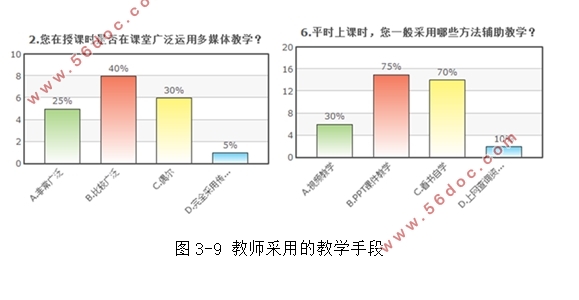网络环境下大学生自主学习能力的培养与教学模式转变的分析(附调查问卷)
来源:56doc.com 资料编号:5D26452 资料等级:★★★★★ %E8%B5%84%E6%96%99%E7%BC%96%E5%8F%B7%EF%BC%9A5D26452
资料以网页介绍的为准,下载后不会有水印.资料仅供学习参考之用. 密 保 惠 帮助
资料介绍
网络环境下大学生自主学习能力的培养与教学模式转变的分析(附调查问卷)(论文12000字)
摘要
网络环境下的教与学已成为了当前教师与学生们备受关注的问题。随着互联网技术的高速发展,教学模式与学习方法都发生了巨大的变化,课堂网络化已成为了当前重要的教育模式之一。本文的研究目的在于了解当前教师教学模式的转变方向与学生的自主学习能力的培养。
本文主要通过问卷调查形式进行数据收集与分析。主要研究内容包括网络环境下的自主学习与教学模式的理论综述、网络环境下的自主学习与教学模式的特征、国内外研究现状与发展动态、网络环境下教学模式转变的影响因素分析、网络环境下教学存在的问题以及提出的建议等。
关键词:网络环境 自主学习能力 教学模式 培养 转变
The cultivation of college students' autonomous learning ability under the network environment and the change of teaching mode of analysis
Abstract
Under the network environment of teaching and learning has become the current teachers and the students attention problem,teaching and learning methods are all great changes have taken place with the rapid development of Internet technology,network class has become one of the important education mode. Understand the current teaching model of a change of direction and students' autonomous learning ability by studying this subject.
This paper mainly collects and analyses through the questionnaire survey form for data. The main research contents have autonomic learning under the network environment with the theory of teaching model were reviewed、under the network environment of the autonomous learning and the characteristics of the teaching mode domestic and foreign research present situation and the development trends the influence factors of the teaching mode under the network environment change analysis under the network environment teaching existing problems and Suggestions and so on.
Key words: Network environment; autonomous learning ability; of teaching mode; cultivation; change

目录
摘要 I
Abstract II
第一章 绪论 1
1.1 研究背景及意义 1
1.2 主要研究内容 2
1.3 研究方法 3
第二章 文献综述 5
2.1 自主学习的定义 5
2.2 网络环境下自主学习的特征 5
2.3 教学模式的发展历程 6
2.4 网络环境下教学模式的特征 7
2.5 国内外研究现状 8
2.5.1 国内研究现状 8
2.5.2 国外研究现状 8
第三章 调查与分析 10
3.1 调查目的 10
3.2 问卷设计 10
3.3 数据整理与分析 10
3.4 网络环境下教学模式转变的影响因素分析 13
3.5 网络环境下教与学存在的问题分析 14
第四章 建议 16
4.1 学生方面 16
4.2 教师方面 16
4.3 学校方面 16
4.4 社会方面 16
第五章 结束语 17
参考文献 18
附录 21
致谢 23
|



